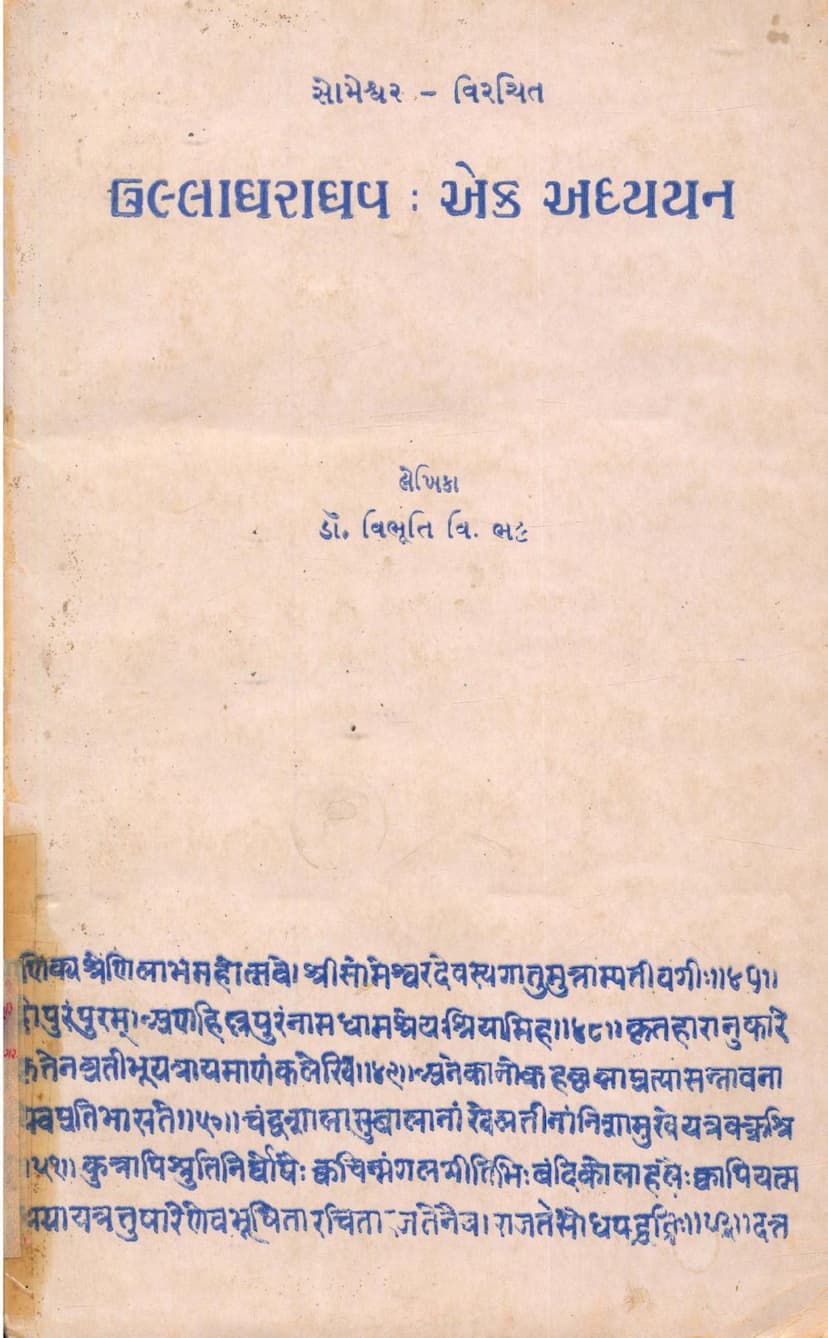Ullaghraghav Ek Adhyayan
Added to library: September 2, 2025

Summary
Here is a comprehensive summary of the Jain text "Ullaghraghav Ek Adhyayan" by Vibhuti V Bhatt, based on the provided pages:
Book Title: Ullaghraghav Ek Adhyayan (A Study of Ullaghraghav) Author: Dr. Vibhuti V. Bhatt Publisher: Vibhuti V. Bhatt Catalog Link: https://jainqq.org/explore/005744/1
This book, "Ullaghraghav Ek Adhyayan," is a scholarly study of the Sanskrit drama "Ullaghraghav" (also known as "Ramnatak" or "Ramayannatak") authored by Someshwar Dev. The author, Dr. Vibhuti V. Bhatt, presents a detailed analysis of this significant play within the context of Gujarat's rich literary heritage, particularly during the Solanki and Vaghela periods.
Author's Perspective and Objective: Dr. Bhatt positions Someshwar Dev as the second most important literary figure in Gujarat after Hemchandracharya during the Solanki era. She highlights Someshwar's prolific contributions across various literary genres, including epic poems, dramas, and devotional works. Her primary objective in writing this book was to study and present all the works of this great Gujarati scholar, with a particular focus on "Ullaghraghav," which she considers instrumental in placing Someshwar among India's renowned poets.
Significance of Ullaghraghav: Dr. Bhatt emphasizes that "Ullaghraghav" is a classical Sanskrit drama based on the Ramayana, filling a perceived gap in Gujarati literature regarding a comprehensive work on the epic. The play meticulously covers the narrative of Rama, primarily focusing on his return to Ayodhya.
Key Aspects of the Study:
-
Author and Publisher: The book is authored and published by Dr. Vibhuti Vikram Bhatt. It was first published in February 1989 with a print run of 750 copies. The publication was supported by the Gujarat Sahitya Akademi.
-
Structure of the Book: The book features a detailed table of contents, indicating chapters on the poet (Someshwar Dev) and his introduction, the plot (Kathaanak), "Ullaghraghav" as a drama, its poetic and lyrical elements, its emotional and aesthetic aspects, characterization, plot construction, the influence of earlier poets, and a conclusion.
-
Someshwar Dev's Background:
- The study begins by introducing Someshwar Dev, a prominent Sanskrit poet from Gujarat during the Solanki-Vaghela period.
- His ancestors held the hereditary position of royal priest (Rajpurohit) for the Chalukya kings, tracing back to Solaksharma who was appointed by Mulraj I.
- Information about Someshwar's birth and death is scarce, but his father, Kumar, served as the priest for King Ajaypal and the young Mulraj II, even acting as a guardian and commander.
- Someshwar Dev likely served as a royal priest during the reigns of Bhimdev II and Vishaldev, and had close ties with prominent figures like Lavanprasad, Viradhaval, and the ministers Vastupal and Tejpal.
- His other known works include "Surathotsava" (a Mahakavya), "Kirtikaumudi" (a historical Mahakavya), "Ullaghraghav" (the drama), "Ramshatak," and various compilations of verses.
-
Analysis of Ullaghraghav:
- Plot (Kathaanak): The drama unfolds in eight acts, starting after Sita's swayamvar and marriage, covering events up to Rama's coronation in Ayodhya. The plot is presented in a detailed, act-by-act summary, highlighting key dialogues, character interactions, and plot developments. Notable scenes include Janaka's farewell to Sita, discussions in Ayodhya, Rama's contemplation of destiny, the machinations of Manthara, Kaushalya and Sumitra's emotions, Rama's departure to the forest with Sita and Lakshmana, the arrival of Gandharvas and their mystical narratives, the tragic demise of Dasharatha, the ensuing political turmoil in Ayodhya, Bharat's reaction, the war preparations, the introduction of characters like Sugriva, Hanuman, Vibhishana, Kumbhakarna, and Indrajit, and ultimately Rama's triumph and return to Ayodhya, culminating in Sita's ordeal and acceptance.
- Dramatic Elements: The study delves into the play's adherence to Sanskrit dramatic conventions, including the use of Arthopakshepakas (narrative interludes like Vishkambhaka, Praveshaka, etc.) to bridge gaps in time and continuity. The detailed analysis of the Sandhis (parts of a drama) and their constituents (Angas) demonstrates Someshwar's mastery of dramatic theory.
- Rasa and Bhava: Dr. Bhatt analyzes the presence and prominence of various Rasas (emotions) in the play. She identifies Virarasa (heroic sentiment) as dominant, with sub-categories like Yuddhavir (warrior's valor) and Dharmavir (heroism in upholding duty) being well-represented. Karunaras (pathos) is also noted, particularly in the scenes of separation and sorrow. Shringara (romantic sentiment) is present but kept subtle, often leading to moments of gentle humor. Raudrarasa (anger) and Bhayanakarasa (terror) are depicted in the portrayals of characters like Parashurama, Ravana, and the battle scenes. Bibhatsarasa (disgust) appears in descriptions of violence and Ravana's character. The study also touches upon the use of Hasyarasa (humor) through the character of the Vidushaka (jester).
- Poetic and Lyrical Elements: The book examines the play's poetic quality, including the prevalent meters (like Shardulvikridita and Vasantatilaka), the use of metaphors and similes (Alankaras), and the overall lyrical flow.
- Characterization: The study provides an in-depth analysis of the characters, highlighting their individual personalities and motivations. Rama is portrayed as the ideal hero, embodying virtue, duty, and compassion. Sita is depicted as a devoted wife, virtuous, and capable of enduring hardship. Ravana, the antagonist, is shown with his arrogance, power, and underlying vulnerability. Other characters like Lakshmana, Bharata, Dasharatha, Janaka, Vibhishana, and the Vidushaka are analyzed for their specific roles and contributions to the narrative and thematic development. The author notes Someshwar's innovative inclusion of the Vidushaka in a serious play like this.
- Influence of Predecessors: Dr. Bhatt discusses the influences of earlier poets and playwrights, particularly Valmiki's Ramayana, Bhasa, Kalidasa, Bhavabhuti, Murari, and Jayadeva, on Someshwar's work. She identifies instances of "shadow imitation" (Chhayanutkarana) and "shadow play" (Chhaya Natya), where Someshwar adapts and reinterprets existing narratives with his unique style and perspective.
Overall Contribution: "Ullaghraghav Ek Adhyayan" is presented as a significant contribution to the study of Sanskrit drama and the literary history of Gujarat. Dr. Bhatt's meticulous research and detailed analysis shed light on Someshwar Dev's "Ullaghraghav," offering valuable insights into its dramatic structure, poetic merit, characterization, and its place within the broader tradition of Ramayana literature. The book aims to bring this often-overlooked masterpiece to the forefront of scholarly attention.